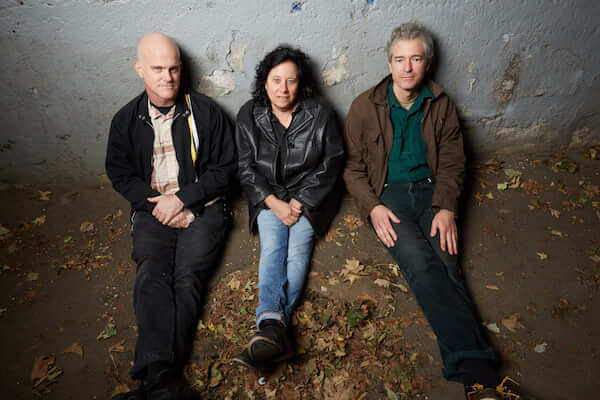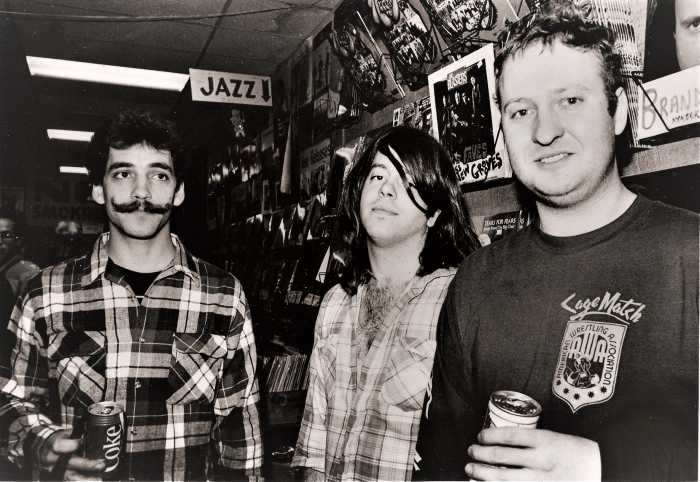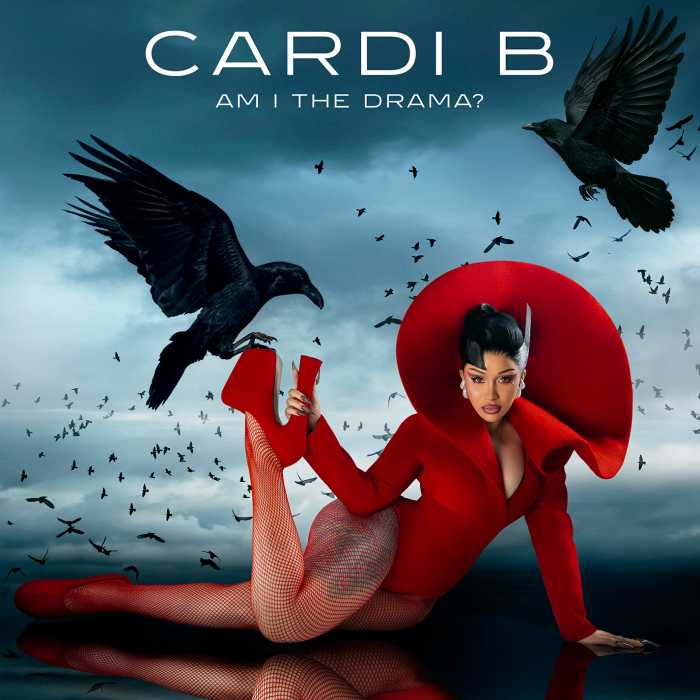E’s Gavin McCarthy, Thalia Zedek, and Jason Sanford. | KELLY DAVIDSON
The Boston trio E are a relatively new group. Its members came together in 2013 and released a self-titled 2016 debut. Their latest album, “Negative Work,” is their sophomore effort.
E features the contributions of out lesbian singer/ guitarist Thalia Zedek, who has a history in music stretching back more than three and a half decades. She made her recorded debut as the singer of the Dangerous Birds on their early 1980s single “Smile On Your Face.” From there, she joined the Boston band Uzi and sang on their EP “Sleep Asylum,” then the New York band Live Skull, replacing their original vocalist for their album “Dusted. Along with Sonic Youth and Swans, Live Skull were part of the post-No Wave noise-rock scene, although they didn’t have the longevity both of those bands found or the relative commercial success Sonic Youth achieved.
Zedek’s next band, Come, emerged just as grunge widened the audience for indie rock. Many people predicted that Come would emerge as stars. While that didn’t happen, they achieved a level of cult success akin to bands like Guided By Voices and Sebadoh, enough so that Matador Records reissued their 1992 debut “11:11” in a deluxe edition 11 years later and they reunited from 2010 to 2013. Come pursued an accessible, blues-based sound in contrast to the far more abrasive Live Skull, even covering the Rolling Stones. They named their second album “Don’t Ask, Don’t Tell.” When Zedek went solo, the audience for Come did not really follow, although she’s worked steadily her entire career.
Boston indie trio produces solid, if not memorable, offering
E mark a return to the noise quotient of Zedek’s work with Live Skull. Upfront, there are two distinctive things about their sound: they have no bassist and the group’s other singer/ guitarist, Jason Sanford, feeds his instrument through three effects pedals he built himself. One was made with a hacksaw blade. According to the album’s press release, Sanford deliberately incorporates “microtonal abnormalities.”
Given Zedek’s long history in indie rock, it’s not surprising that E evokes that music’s sound from the 1990s and 2000s. Her bandmates, who also include drummer Gavin McCarthy, have their own histories in groups with which I’m not familiar. They too look middle-aged in press photos.
Sonic Youth casts a long, if probably unintentional, shadow over “Negative Work.” Sanford’s use of his effects pedals recalls that band’s guitarists Thurston Moore and Lee Ranaldo’s alternate tunings to create unusual sounds, although E have much less interest in combining their love for sustained noise with pop song structures.
McCarthy’s drumming is extremely syncopated. E’s rhythmic sense suggests elements of prog-rock and funk with an aggression that could only have emerged after punk, without ever sounding quite like any of these genres. This calls to mind post-hardcore bands like Fugazi and Drive Like Jehu. The band often works with Zedek and Sanford both playing rhythm guitar in tight unison to McCarthy’s beats. Then, one guitarist will dart out to play lead.
The fact that the band doesn’t have a formal rhythm section, since there’s no bassist, changes the way Zedek and Sanford approach their guitars. They often use their instruments to fill in the sound’s holes and reinforce the beat as a bass player would in a more conventional rock band. (On “The Projectionist,” there’s a passage where the guitar sounds completely bottom-heavy, scratchy, and unmelodic, almost like a James Brown riff.) McCarthy’s reliance on rolls on his snare drum and tom-toms evokes Kenny Morris’ drumming on Siouxsie and the Banshees’ debut album “The Scream” and, more generally, the “tribal” approach to percussion in much early Goth music.
Zedek began making music when post-punk was a new concept and she’s still at it in her late 50s. E sound like a band out of time, in part because loud electric guitars are unfashionable now and rock groups seem to be in a rush to ditch them in favor of electronic instrumentation, even if “Cannibal Chatroom” is an attack on the downside of the Internet.
While they’re not a nostalgia trip, given that E’s members are contemporaries of the artists they sound like, they don’t really do anything new with the sounds they use. Iconic indie labels like Touch & Go or Dischord could have released “Negative Work” circa 2002. The fact that it was recorded in four days lends it a raw sound, although the production never aims for a low-fi feel. “Negative Work” is a solid album, but it’s not one I’m likely to play much more now that this review is complete.
E | “Negative Work” | Thrill Jockey | May 25 release | thrilljockey.com/press/e-e





































